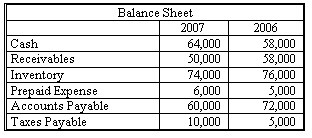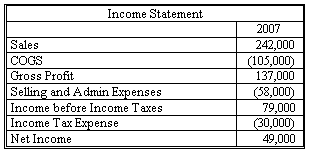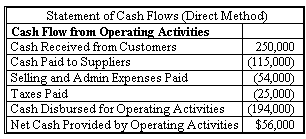- CFA Exams
- 2025 Level I
- Topic 4. Financial Statement Analysis
- Learning Module 4. Analyzing Statements of Cash Flows I
- Subject 3. Cash Flows from Operating Activities: The Direct Method
Why should I choose AnalystNotes?
Simply put: AnalystNotes offers the best value and the best product available to help you pass your exams.
Subject 3. Cash Flows from Operating Activities: The Direct Method PDF Download
The beginning and ending cash balances on the statement of cash flows tie directly to the Cash and Cash Equivalents accounts listed on the balance sheets at the beginning and end of the accounting period.
Net income differs from net operating cash flows for several reasons.
- Non-cash expenses, such as depreciation and the amortization of intangible assets, require no cash outlays, reduce net income but do not affect net cash flows.
- Many timing differences exist between the recognition of revenue and expense and the occurrence of the underlying cash flows.
- Non-operating gains and losses enter into the determination of net income, but the related cash flows are classified as investing or financing activities, not operating activities.
There are two methods of converting the income statement from an accrual basis to a cash basis. The direct and indirect methods are alternative formats for reporting net cash flows from operating activities. Both methods produce the same net figure (dollar amount of operating cash flow). Companies can use either method for reporting their operating cash flow.
The direct method discloses operating cash inflows by source (e.g., cash received from customers, cash received from investment income) and operating cash outflows by use (e.g., cash paid to suppliers, cash paid for interest) in the operating activities section of the cash flow statement.
- It adjusts each item in the income statement to its cash equivalent.
- It shows operating cash receipts and payments. More cash flow information can be obtained and it is more easily understood by the average reader.
Under IFRS and U.S. GAAP, both the direct and indirect methods are acceptable for financial reporting purposes. However, the direct method discloses more information about a company. Partly because companies want to limit information disclosed, the indirect method is more commonly used.
The reporting of investing and financing activities is the same for both direct and indirect methods. Only the reporting of CFO is different.
Direct Method
Under the direct method, the statement of cash flows reports net cash flows from operations as major classes of operating cash receipts and cash disbursements. This method converts each item on the income statement to its cash equivalent. The net cash flows from operations are determined by the difference between cash receipts and cash disbursements.
Assume that Bismark Company has the following balance sheet and income statement information:


Additional information:
- Receivables relate to sales and accounts payable relates to cost of goods sold.
- Depreciation of $5,000 and pre-paid expense both relate to selling and administrative expenses.
Direct Method:
Cash sales: sales on the accrual basis are $242,000. Since the receivables have decreased by $8,000, the cash collections are higher than accrual-basis sales.
Sales: $242,000
Add decrease in receivables: $8,000
Cash sales: $250,000
Cash purchases: since inventory decreased by $2,000, goods purchased in prior years were used as the cost of goods sold. Since accounts payable decreased by $12,000, more cash was paid in 2000 for goods than is reported under accrual accounting.
Costs of goods sold: $105,000
Deduct decrease in inventories: $2,000
Add decrease in accounts payable: $12,000
Cash purchases: $115,000
Cash selling and administrative expenses: the selling and administrative expenses include a non-cash charge of $5,000 related to depreciation. In addition, pre-paid expenses (assets) increased by $1,000 and should be added to the selling and administrative expenses.
Selling and administrative expenses: $58,000
Deduct depreciation expense: $5,000
Add increase in pre-paid expense: $1,000
Cash selling and administrative expenses: $54,000
Cash income taxes: income tax on the accrual basis is $30,000. Tax payable, however, has increased by $5,000. This means a portion of the taxes has not been paid. As a result:
Income tax expense: $30,000
Deduct increase in taxes payable: $5,000
Income tax paid: $25,000
The presentation of the direct method for reporting net cash flow from operating activities:

User Contributed Comments 0
You need to log in first to add your comment.

You have a wonderful website and definitely should take some credit for your members' outstanding grades.

Colin Sampaleanu
My Own Flashcard
No flashcard found. Add a private flashcard for the subject.
Add